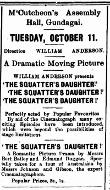 6038859911665016089.jpg
6038859911665016089.jpg
 6038859911665016089.jpg
6038859911665016089.jpg
'In a famous study, The Australian Legend, first published in 1958, Russel Ward argued that the bush legend was the central foundation story that explained the evolution of Australian character and nationalism. Ward's version of the legend explained how from convict times onwards itinerant bush workers had created and adhered to an ethos that encompassed mateship, anti-authoritarianism (including hostility to Britain and its empire), egalitarianism, and adaptability. Although the bush legend allegedly originated with and was nurtured by a bush proletariat, Ward proposed that this regional ethos became a national creed at the turn of the 20th century, transmitted from rural to urban Australia through conduits that included the trade union movement, periodicals like The Bulletin, and the work of writers like Lawson and Paterson. (Publication abstract)
'In a famous study, The Australian Legend, first published in 1958, Russel Ward argued that the bush legend was the central foundation story that explained the evolution of Australian character and nationalism. Ward's version of the legend explained how from convict times onwards itinerant bush workers had created and adhered to an ethos that encompassed mateship, anti-authoritarianism (including hostility to Britain and its empire), egalitarianism, and adaptability. Although the bush legend allegedly originated with and was nurtured by a bush proletariat, Ward proposed that this regional ethos became a national creed at the turn of the 20th century, transmitted from rural to urban Australia through conduits that included the trade union movement, periodicals like The Bulletin, and the work of writers like Lawson and Paterson. (Publication abstract)